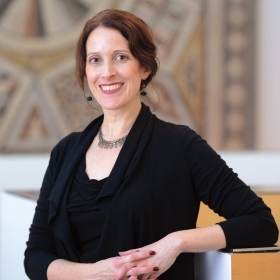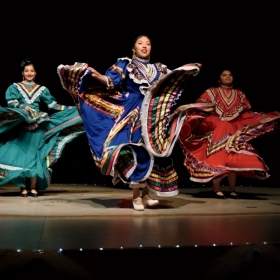Bryan Burns uses technology to allow his students to virtually move through an archaeological site from Early Mycenaean tombs in ancient Eleon, a dig site north of Athens.

Photo by Richard Howard
A student in the Knapp Media and Technology Center picks up an ancient jewelry mold made of soapstone, rotating it in her hand. Then, a painted water jug dating back to 1700 B.C.E.
The objects are among those Associate Professor of Classical Studies Bryan Burns and a summer team of student archaeologists have excavated from Early Mycenaean tombs in ancient Eleon, a dig site north of Athens.
But the student at the Knapp is “handling” the objects from thousands of miles away. She dons a headset and uses hand controllers to virtually move through the archaeological site, manipulating objects as she goes.
A specialist in Greek civilization, Burns has long used technology to bring ancient artifacts to life. Since 2011, he’s taken a group of students to Greece for an intense, six-week dig alongside colleagues and students from across the globe. Their group was the first to uncover Eleon’s treasures, digging, maneuvering wheelbarrows, and measuring artifacts through heat waves. They’ve uncovered objects that show how the community developed sophisticated trading networks.
Burns has scanned objects from Eleon—coins, cups, weapons, tools—to give more people access, and used Google Maps and TimeMapper to place ancient objects on modern, interactive maps. He and his team have also flown a drone over Eleon, collecting data to make 3D models.
This year, they combined the models with images captured by a hand-held scanner to create their second-generation virtual-reality experience prototype. Next year, Burns hopes to complete a version they can share with the public.
“What began as an effort to get aerial photography has become a whole new way to record information and get results,” says Burns. Tombs, which predate Classical Greece, often contain the remains—and prized possessions—of multiple people. “They’re very complex. It’s one reason we love to create these digital records.”
Burns arrived at Wellesley in 2008 and teaches a course on Bronze Age Greece and one called Gods and Heroes. He’s also published a book, Mycenaean Greece, Mediterranean Commerce, and the Formation of Identity.
For Burns, Eleon is a study of resilience. In 1200 B.C.E., Greece’s palatial centers and capitals were wiped out. “But in Eleon, people were fine,” he says. There’s still much to be unearthed to complete the tale of how Eleon survived, and even thrived, as other communities around it fell.


